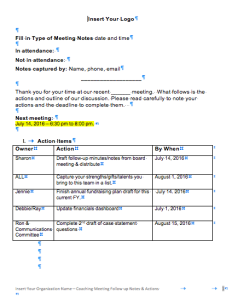Your board meeting or fundraising committee meeting ends with a buzz.
Everyone is excited about the direction things are heading at your nonprofit organization. People even agreed to take on tasks. With deadlines.
Yet, a month or so later when you meet you are disappointed. . . again.

Calls weren’t made.
Tickets weren’t sold.
Doors weren’t opened.
Reports weren’t reviewed.
You aren’t even sure people read the meeting minutes/notes.
I’m sorry to tell you, it’s usually not about them. It’s about how the follow-up communication is prepared and delivered.
In my experience it’s the notes and follow-up that can have a significant impact on your team’s effectiveness. Easy to follow information that makes it effortless to find relevant information produces the best results.
For me, personally, if people aren’t doing what I want them to do I make it a habit to take a look at how I delivered my communication.
Were there too many long paragraphs? Too many pages to weed through to find what pertained to me? Were the notes simply a word for word account of what was discussed?
I hope your answer is no to all of the above.
Borrowed from my colleague and friend Sarah, with a few updates of my own, I have a powerful, simple Word document for effectively capturing what happens at meetings. I’ve watched small, medium and large organizations use this format and dramatically increase their accomplishments.
Board and committee members and even staff have told me they appreciate the details on the first page about what they agreed to do along with a short recap on the following pages.
Best practices for using this note taking format
- A volunteer or staff person documents all of the actions agreed to during the meeting.
- The same volunteer or staff person makes sure to include and ask if it’s not obvious: By when will that action be completed?
- A PDF of the notes are shared using this format within 24 hours of the meeting.
- At the start of each meeting the Action Table from the start of the document is reviewed and updated, with a new “by when” promise if need be.
- Once an action has been missed again after a single “re-promise” the documenter lets the volunteer or staff member know that your team will have to redistribute the action or task.
The document then becomes the To Do follow-up list for each meeting. By listing To Do’s at the start without any narrative, each person knows exactly what to do and by when they agreed to do it.
Here’s when this document doesn’t work: If there is not a culture of accountability in place from the committee or board chair or manager, people are taught that the deadlines or “by-when’s” don’t matter.
It’s not being rude to ask someone if they finished their task. No matter if they are a volunteer or staff.
It’s actually making it easier for others to do what they said they would do.







